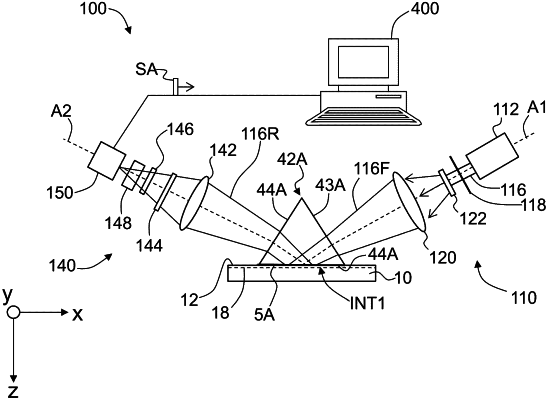| CPC G01L 1/24 (2013.01) [G02B 5/04 (2013.01); G02B 5/3016 (2013.01); G01N 21/21 (2013.01); G01N 2021/4153 (2013.01); G01N 2021/4792 (2013.01)] | 13 Claims |

|
1. An evanescent prism coupling spectroscopy (EPCS) system for characterizing stress in a chemically strengthened (CS) substrate having a surface and a near-surface waveguide, comprising:
a) an EPCS light source system comprising:
i) an EPCS light source that emits a multiwavelength EPCS light beam;
ii) an optical filter assembly configured to sequentially filter the multiwavelength EPCS light beam to form a sequence of filtered EPCS light beams having different wavelengths;
iii) a light guide assembly that transfers the sequence of filtered EPCS light beams as guided light to a focusing optical system arranged to receive the transferred filtered EPCS light beams and form therefrom a sequence of filtered and focused EPCS light beams;
b) an EPCS coupling prism that forms an EPCS coupling surface with the surface of the CS substrate and that receives and couples the sequence of filtered and focused EPCS light beams into and out of the near-surface waveguide at the EPCS coupling surface to form a sequence of filtered and reflected EPCS light beams that respectively comprise mode spectra of the near-surface waveguide for the corresponding filtered and reflected EPCS light beam; and
c) an EPCS detector system comprising:
i) a switchable polarization filter operably connected to a polarization controller to sequentially perform transverse magnetic (TM) and transverse electric (TE) polarization filtering of the sequence of filtered and reflected EPCS light beams to form TM and TE filtered and reflected EPCS light beams respectively comprising TM and TE mode spectra of the near-surface waveguide; and
ii) an EPCS digital detector configured to sequentially detect the sequence of TM and TE filtered and reflected EPCS light beams to sequentially capture TM and TE images of the respective TM and TE mode spectra of the near-surface waveguide at the different filter wavelengths.
|